As could be expected, things are out of control. I’m now planning on using the Pi to run a mirrored RAID array for network storage (my old RAID NAS just bit the dust) and now I’m shopping for cool old desktop radios to get a little restomod action...
In reply to Keith Tanner :
I'm about to put a 2x 2Tb mirrored USB up on Marketplace. WD My Book Duo.
Seems like something that could find a place in your plans, and I can make it available to you at a good price.

In reply to Keith Tanner :
Kieth in the future try using shellack. You will absolutely love it. First because it's much more original, second the first coat dries in 15 minutes., third it comes in several colors. (clear amber, rouge, black, the later 2 I rarely find)
Unlike polyurethane it's not plastic and does not look like it. Shellack has a richness and depth no polyurethane ever will. If you scratch or damage shellack new coats melt into old coats and make invisible repairs, even decades later.
Shellack is much harder than Polyurethane and while it is vulnerable to alcohol damage or extended water left on it. Those can be corrected by a rag dampened indenatured alcohol which will remove the white then reapply shellack to that area. Invisable repair that because of shellack fast drying nature is done quickly.
Painting with shellack is something even you 5 year old can do without runs. Well it runs but it all runs together and melts so runs disappear.
I'm a horrible painter. My most frequent brush is a big 5 incher that I let dry out between uses. I also leave the lid off and just let it evaporate. Then when I need to paint I pour denatured alcohol in wait a bit and start slopping it on.
Don't be shocked! I learned that from a very high end violin restorer. That's the way it's done. Maybe not with a barn brush like I use but just as casual.
the process is two parts denatured alcohol ( also used for camping stoves) to one part of shellack. Let dry. If you feel the paint after 15 minutes you'll feel the little wood nubs that have been raised. Sand those with 320 grit I use a random DA sander but that's because I'm doing whole floors or big stuff. You can do it by hand on smaller delicate stuff . Keep feeling until the nubs are gone ( it's very light work don't use a lot of pressure) now wipe off all the white.
Slop on another coat. This coat takes twice as long to dry. Now feel for any missed nubs and sand those areas as before. Wipe off the white again and give it another coat. Again twice as long to dry as the last coat. ( 1 hr) if you like you can quit or put more coats on for more depth of shine. It will never look plastic. Just a richness and depth you cannot duplicate.
Shellack is a natural product, it's what coats pills. So no finish is as safe or as renewable ( it comes from the Lac bug in India)

Thanks Frenchy. How does shellack deal with existing, non-shellack finishes?
This thing was not made of beautiful solid old-growth timber. It was plywood with a veneer everywhere. It's quite possible it was shellacked the first time. The damage to the top may be indication of that. What's done is done, but I'll keep it in mind. The look right now (other than the dark top) is an old piece that has been used, not a new one. Some bits, like the mouse-chewed leg, were in really bad shape.
Karacticus, you shall have email in just a moment. I've got the Plex server up and running with another drive to prove the concept, but a couple of 2TB should do nicely.
The Plex is working to some extent. The biggest problem is that the drive I hooked up has all my in-car raw video on it, so right in the middle of typical video files you've got "GP010038" that turns out to be 15 minutes of me waiting for my session to start. Car guy problems :)
I have figured out how to build a power on/off switch using the original power switch. This is more complex than just cutting power because computers don't like to just get their power cut. There are a bunch of how-tos on this that involve momentary pushbuttons, but trying to make it work with an on/off switch is less common. With that done - it may actually make more sense to leave this thing powered up all the time. Pis don't use much power at all and it would be annoying to have to turn on the media server. So I'll put in a hidden (momentary!) switch that will do a clean shutdown in the event that I need to unplug the radio cabinet or something. Too bad, it was a cool rig that was more relay logic than programming. The power switch will probably just be used to turn the light on for the tuning dial.
Next, figure out if I can make the old potentiometer work for a volume knob. I have a plan.
In reply to Keith Tanner :
In case PM doesn't work, you can reach me at em jay em wye eee are ess 52349 at gee mail.
So this project took a weird turn, I’ll admit. But I was just watching The Commitments via my 1929 radio and Janel was listening to music as she baked, so I’m not going to complain.
(talking to myself to protect those around me)
I brought my "development" Pi in to work today and fired up the imaginations of everyone. I have been commissioned to create a Plex server by a coworker. He takes gorgeous pictures of my cars so this is a fair exchange.
I just picked up this inoperative beauty on eBay. It's a desktop (ish) unit that I'll turn into an Airplay target using $35 worth of hardware. I'll make sure to keep it in a state where it can be restored to stock because it's a lot more interesting than the Majestic. This means a sensitive disassembly and documentation. Heck, I can probably tuck the Pi Zero in behind the speaker and not have to touch anything but the speaker hookup. I'll check for shellac finish too - it needs a bit of water ring repair on the top.



My friend Eric pointed out that he has an old Philco that he bought at an estate sale for $10, and his wife would like a way to listen to music. So we may leverage all this to come up with a super-easy-to-use design he can install. Eric is solid on the development side of things, but the end result has to be easy to use. It's a non-Apple house so it'll be Bluetooth instead of AirPlay. Let's see what how that works out :)
On the Majestic, I did have a victory today when I got the software equalization to work with the AirPlay emulation. This means I can make that 12" guitar amp speaker sound pretty darn good. That's a big win. Next step is merging the left and right signals into mono in software...without breaking everything else.
Here's what the current case looks like inside, looking down from above. I'll do wire management once I have a couple more parts and I've got the exterior controls integrated. That's a 2TB hard drive at the bottom of the picture, soon to be replaced with a pair of mirrored 2TB twins (thanks, Karacticus!). The power supply for the amp (which also powers the Pi) is fairly hefty because I'm driving a large high impedance speaker. Normally you'd run it off something a bit smaller.
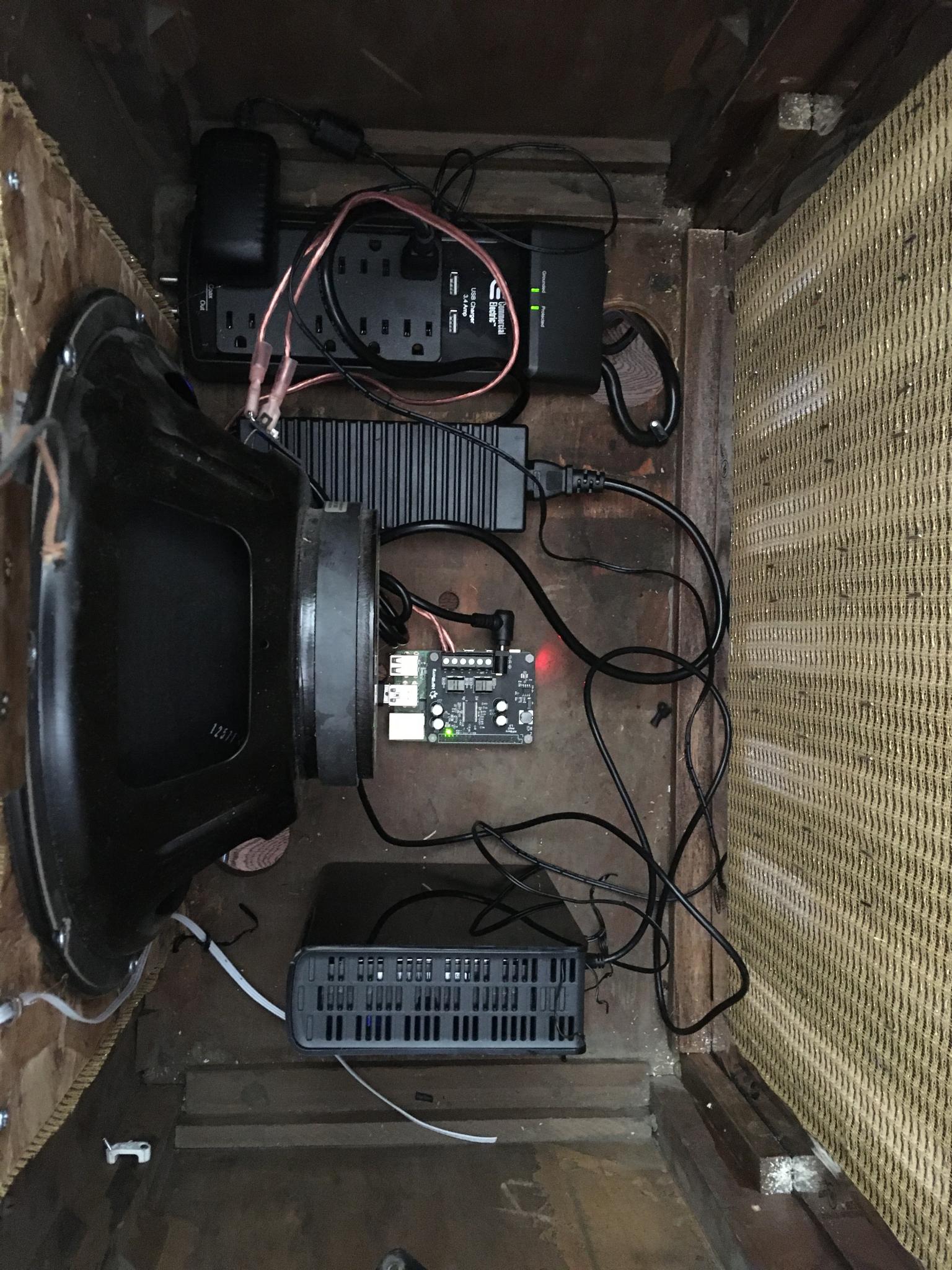
The first part arrived for the 1939 Art Deco GE desktop radio. This is a 3W amp that will sit on top of a Pi Zero W. More on that when it arrives.
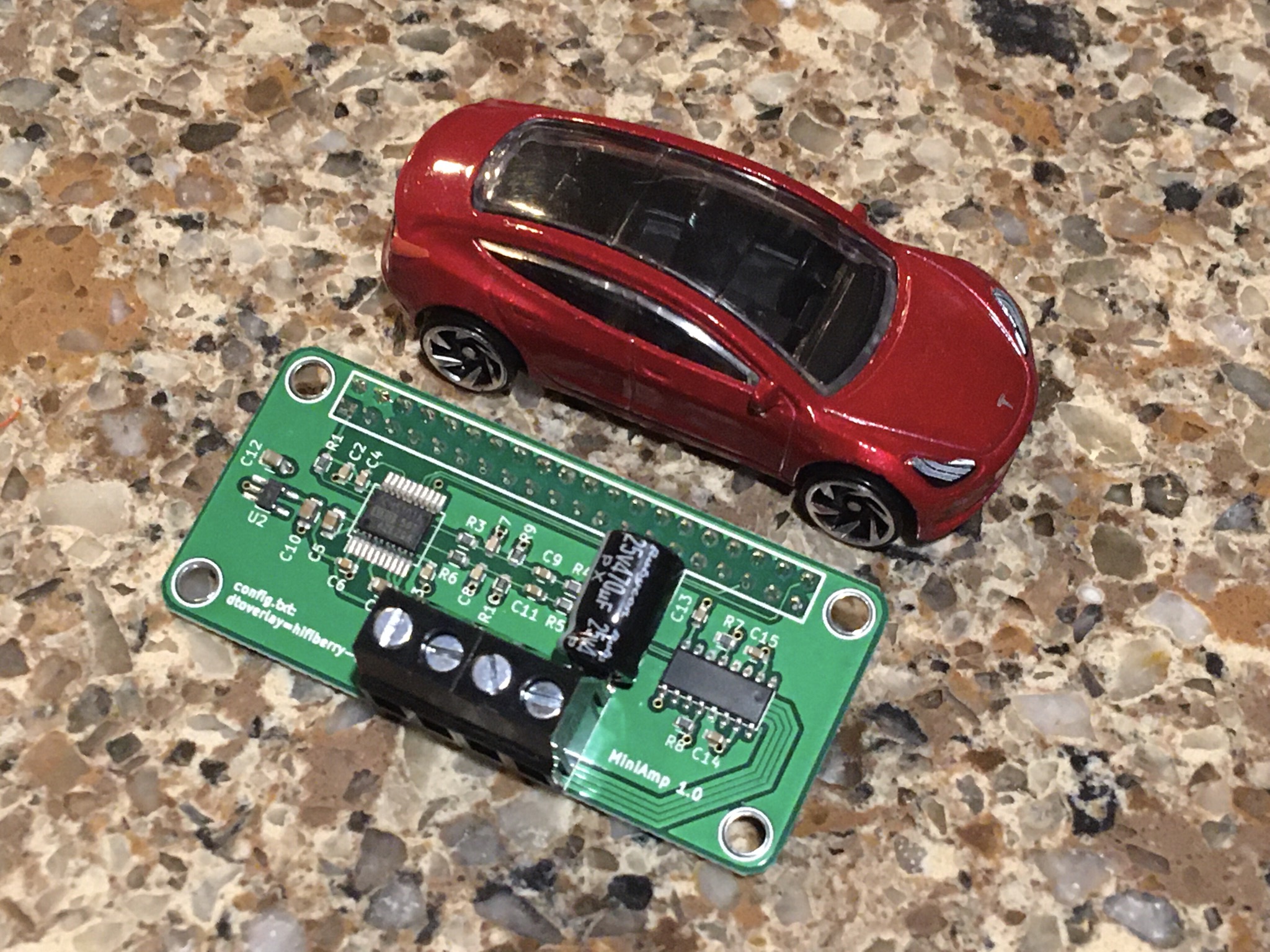
In reply to ShawnG :
I apologize. I sometimes get locked into misspelling a word and just can't shake it.
shellac
thank you.
Shellac.
In reply to Keith Tanner :
Shellac is pretty benign. You can put nearly any finish on top of it and nothing happens.
If you want to put it over something, test the "something" by putting a little denatured alcohol on it. If no reaction then you can go for it. If it softens the old finish you may have shellac. Lay a cloth dampened with denatured alcohol on it and if it wipes off in 15-30 minutes or so, you're in luck. You have shellac
Shellack was a common finish until the mid 1950's when the chemical companies wanted to start selling their cheap plastic versions of Shellac.
Oh the white ring? That tells me it's shellac. Prove it to yourself by setting a denatured alcohol dampened rag on top of it for an hour or so. See? Ring gone.
Oh man, I used to have a collection of over 300 antique radios. I did a LOT of restoration and sales. I am sure you will hear it from purists.. but it breaks my heart to see what you did. I get reasoning nowadays.. but kills me nonetheless.

If you want the removed parts so that another may live, you're welcome to them for the price of shipping! The tubes are wrapped and stored, the rest is boxed and on a shelf.
It's no different than restomodding a car, really. And the Majestic 91 isn't exactly a sought-after variant. It's mostly just old. What I did was take a piece of landfill fodder and make it acceptable to put in a home. The only modification to the case is the hinges for the top and the installation of a back panel (which looks much better now that it's finished than the work-in-progress shot earlier). I recreated the grille because the original was falling apart and pieces were missing, but I had enough to match the original design. The guts were removed intact although I did snip off part of the tuning mechanism rod. That could be welded back on. And I refinished it using "plastic", but with some care.
I've done far worse things to an MGB. I honestly don't care what the purists think in either case, because neither this radio nor the MG were highly valued by said purists.
A much more elegant solution than Sonos. I'll be watching with interest. I inherited an old Zenith table top radio that still works really well, but the ability to stream to something that looks this good is awesome.
If you want any specific details on parts or configuration I'd be happy to help.

The GE F-63 desktop radio is here and I've had a good look at it. It's better made than the Majestic and the case is in far better shape. It's more collectible as well. Call it an Alfa GTV instead of an MGB.
While the Majestic was neglected inside, this one has been...let's say serviced. There are a few modern wires that were added in what looks a lot like a workaround, like the display lights being run off - is that the tube heater? Dude, who would do that? I need to learn more about some of these caps, too, it looks like some have melted or I don't know what. There are a couple of wires with damaged insulation that look like they might have been chewed on. The transformer for the field coil also looks like it's been nibbled on. The radio was sold as inop due to "problems with the power supply", which apparently is common to the F-63. The fact that someone cut off the power cord probably didn't help. There are a few failed solder joints. Basically, it would need a full going-through to resurrect as an original tube radio.
This radio dates from 1938 and had an original price of $725 in 2019 dollars.

The plan for this one is to keep it restorable just in case. The field coil speaker, which is really interesting technically but would be difficult to use, will be removed and replaced with a 6.5" full range speaker that should work nicely. I'll rig the display lights to work when the Pi is powered up - given that they've already been modified, that's just a matter of hijacking one wire that's non-standard. The tube chassis will remain in place and fully populated, all the new bits will hide behind the speaker. I'll do very little to the case, I mostly just want to see if I can do something about the rings on top of the finish.
The electronics on this one are using a Pi Zero, which is a real minimalist little unit. It's got a HiFiBerry 3W "miniamp" plugged in on top. The plan is to have it do nothing but be an AirPlay target, plus run an EQ to get good sound out of the speaker. The console power switch will power the Pi on and off and the display lights will come on with it. I can use that switch with a minimum of disruption so the modification can be easily reversed. I have all the electronics mocked up and working on the bench. The low power Pi is giving me some audio problems that I think are brownouts, I'll check that tonight.
So, very different radio from the Majestic and thus a different approach. As for the Majestic, it's doing a good job as both a speaker and a media server. I added a switch to turn on the case light on demand just because it's fun.
If anyone's actually interested in this at all after the change in direction from "check out this antique radio my mother in law foisted off on me" to "I like to stuff modern electronics in old radio housings", just let me know. I can stop with this.
I'm still watching if that counts for anything. My wood working is going to be on hold for the next year since we are moving into a small rental for our relocation to Kansas. I'll need a hobby.
oh keith, keep going! don't stop! oooh yeah! brown chicken, brown cow and all that.
seriously though, this is a cool thread and i appreciate you documenting all this stuff. just because i'll never do it doesn't mean i don't want to read about it.
I'm interested. I have a zero W and lots of interest in vintage electronics. I'm thinking about how to do this to something appropriate for our library at home. Right now it's some awful blu-ray player hooked to a generic class T amp then hooked to some awesome vintage speakers that I replaced the drivers on. I'm thinking about using your kind of setup inside a vintage component case - something from the 50s so it's period correct for the house. Then still hook to the vintage speakers so it looks like a complete classic separates setup but the guts are modern.
Actually, do you mind if I threadjack a bit and talk about that project? I have a bunch of questions and figured here was a good place to ask.
Have at it, I've threadjacked many a thread in my time.
I shall continue to post pictures of vintage radios in various stages of desecration. Be prepared.

Our patient along with the latest shipment from Adafruit. The radio is beautiful. The dial in particular is made of a gold painted metal, and the section behind the pointers is bent back. The result is that those sections catch the light and glow. It's a fantastic effect. The lighting is behind the main plate so it only hits the bent back sections. I'll get some closeups, but I'm really happy with it. That's a reflection from the silver anti-static bag on the right corner of the radio.
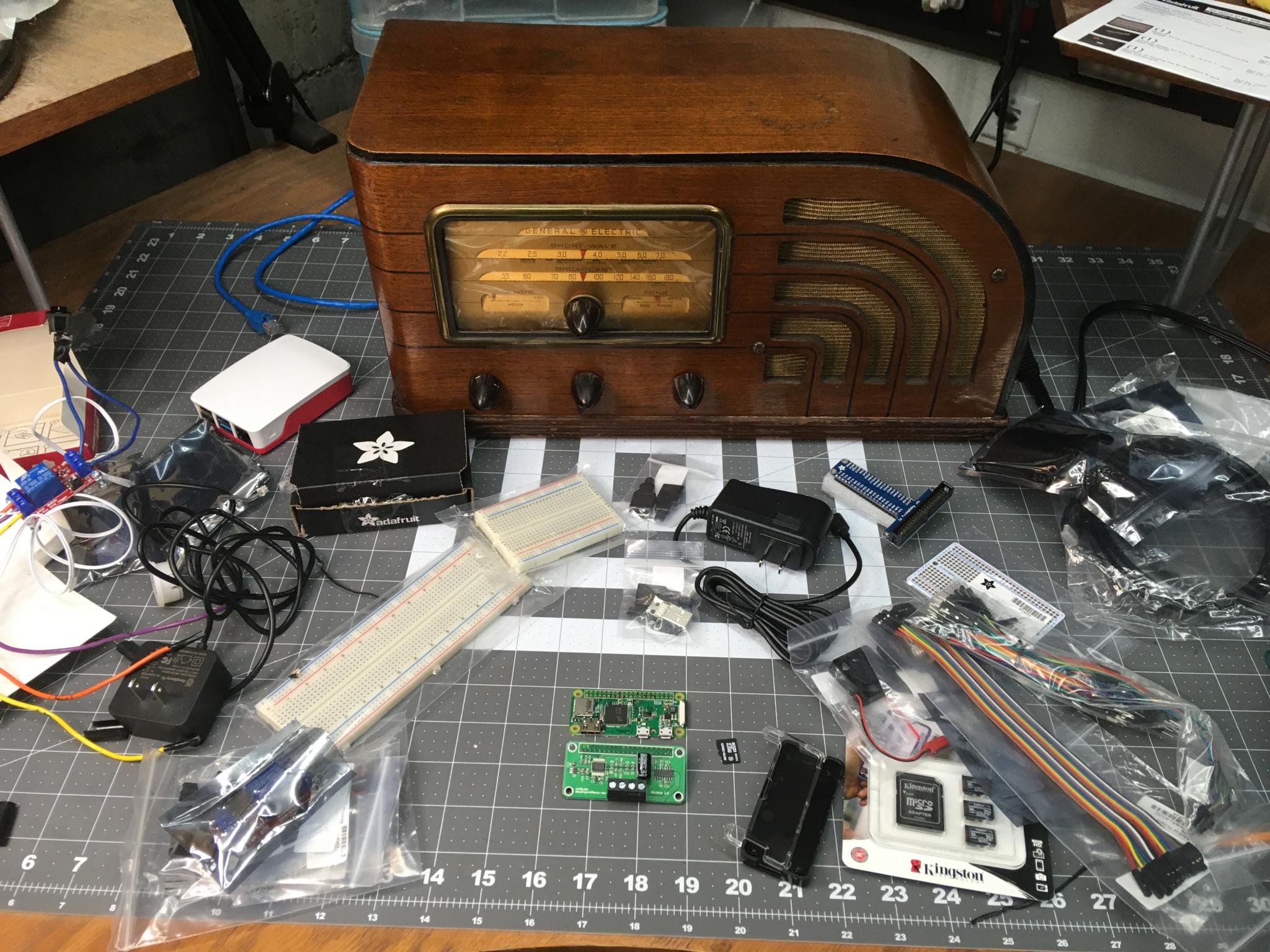
That's the Pi Zero W (W means it has on-board wifi), the amp and a MicroSD card in the front. As you can see, it is roughly the size of a CRX.
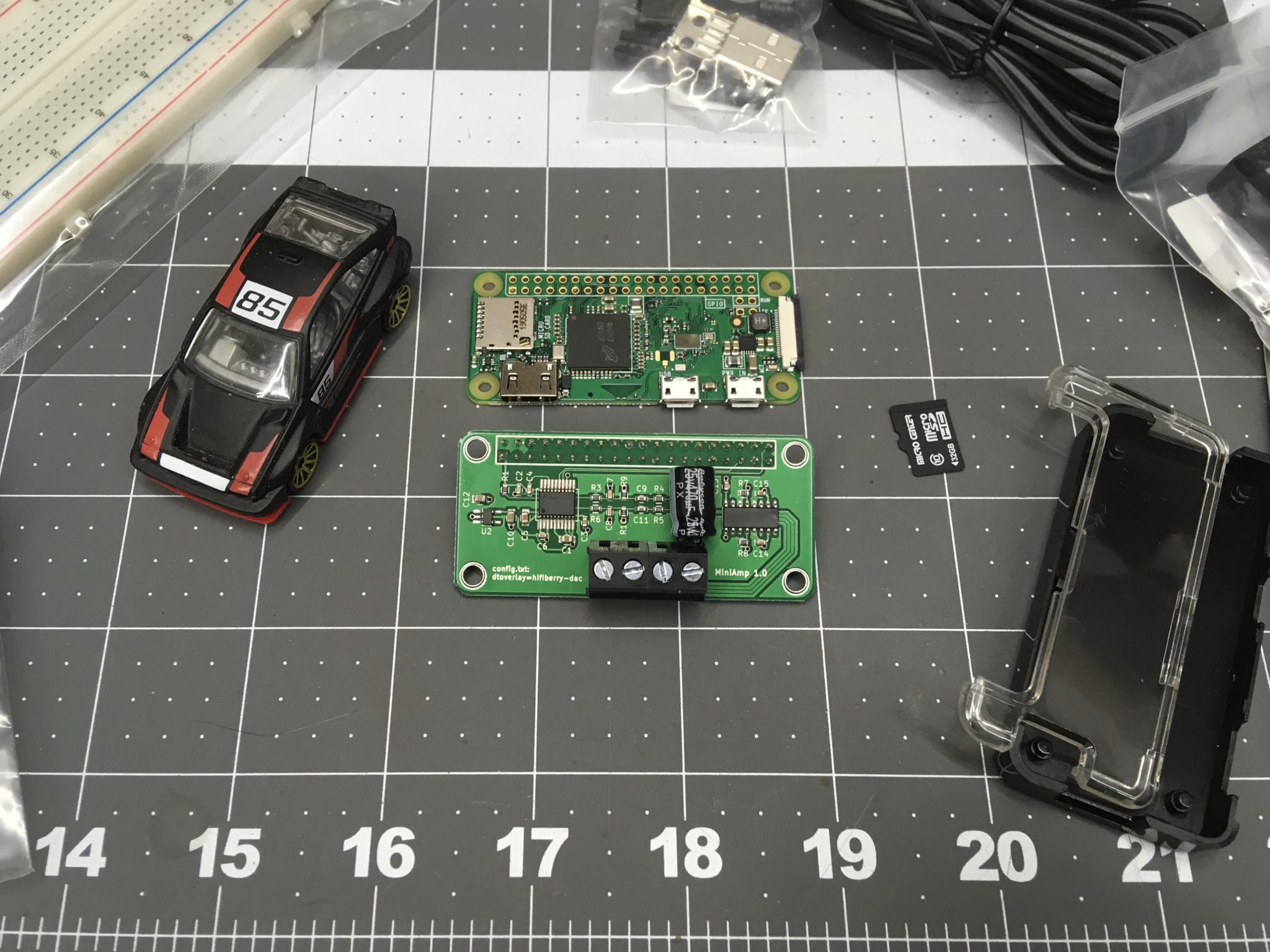
The rings on top. Shellac damage?
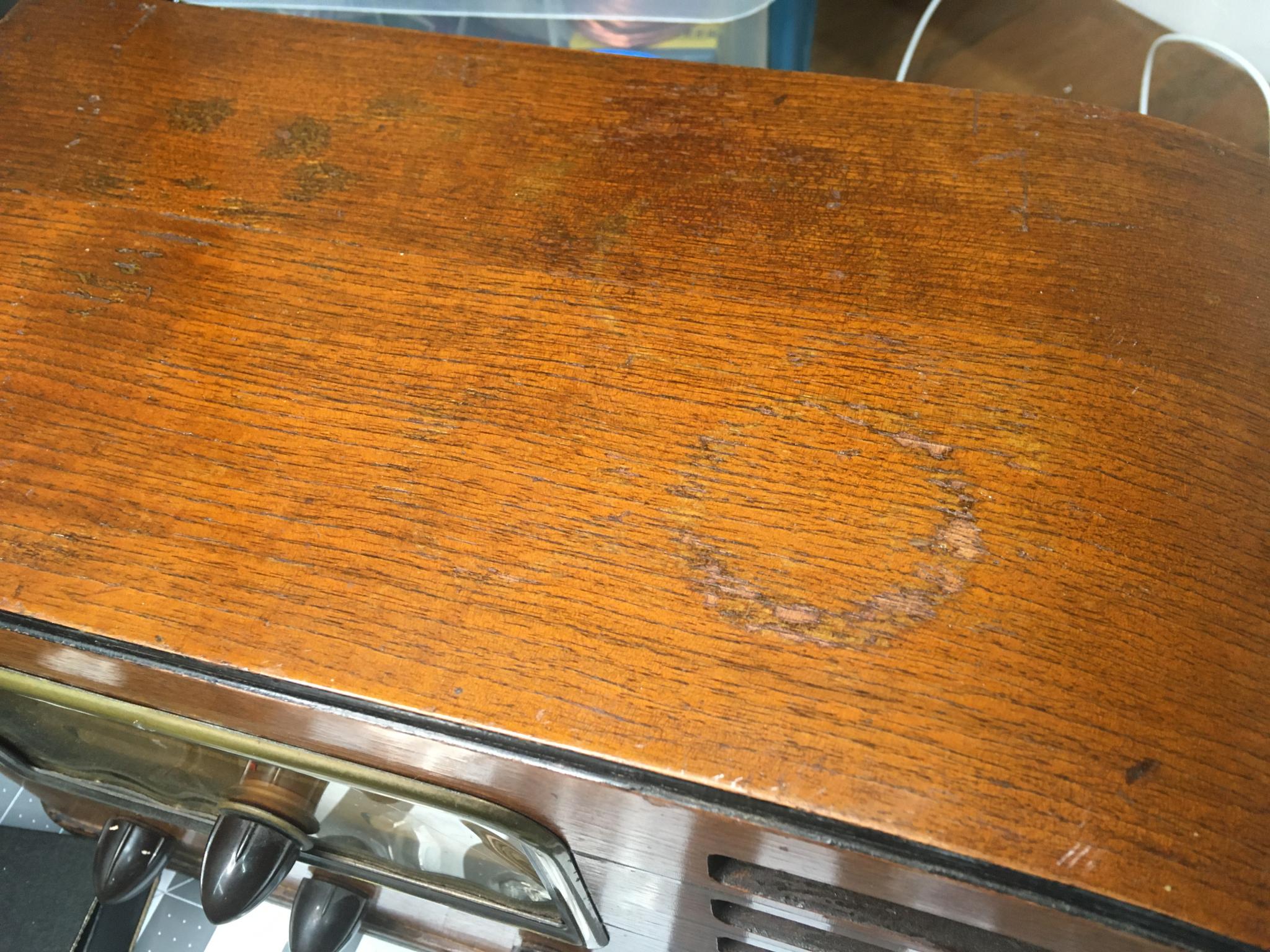
Doing some tuning on the EQ. That's the Pi/amp combo hooked up to the speaker wires. The thing in the red case is my "development" Pi 4, which has a bunch more horsepower under the hood. If I transfer the MicroSD card from one Pi to the other, it will assume that identity. So if the Zero just doesn't have the processing power I need, the upgrade is the easiest possible thing.
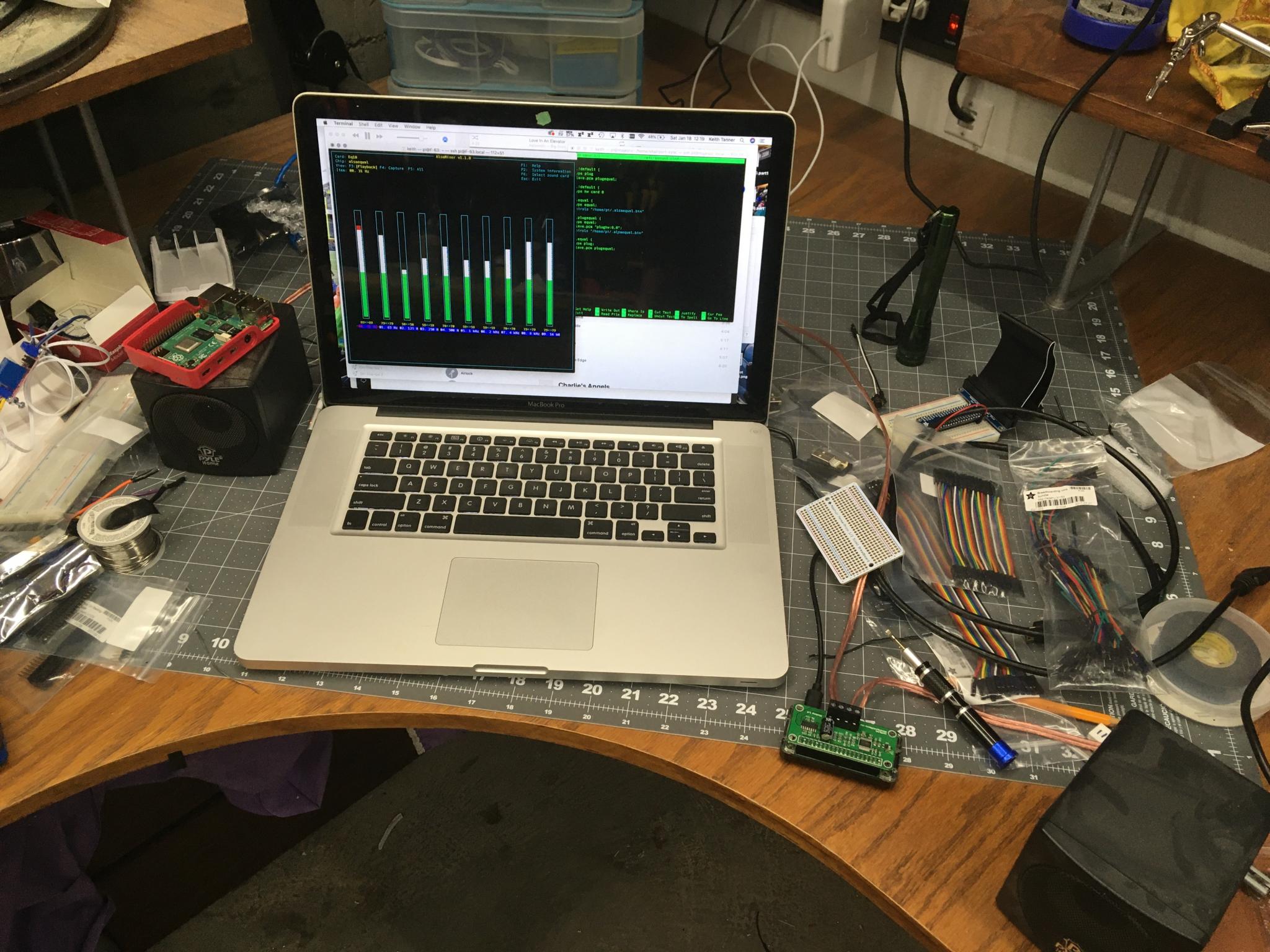
A field effect speaker. Mounted upside down if pictures of other F-63s are any indication. Not fully plugged in either, and I believe this radio will refuse to turn on if the speaker is unplugged. A fun note I found about field effect speakers:
“Be very careful when making connections to amps originally used with field coil speakers. You should expect several hundred volts to appear at the speaker connector.”
Exciting.
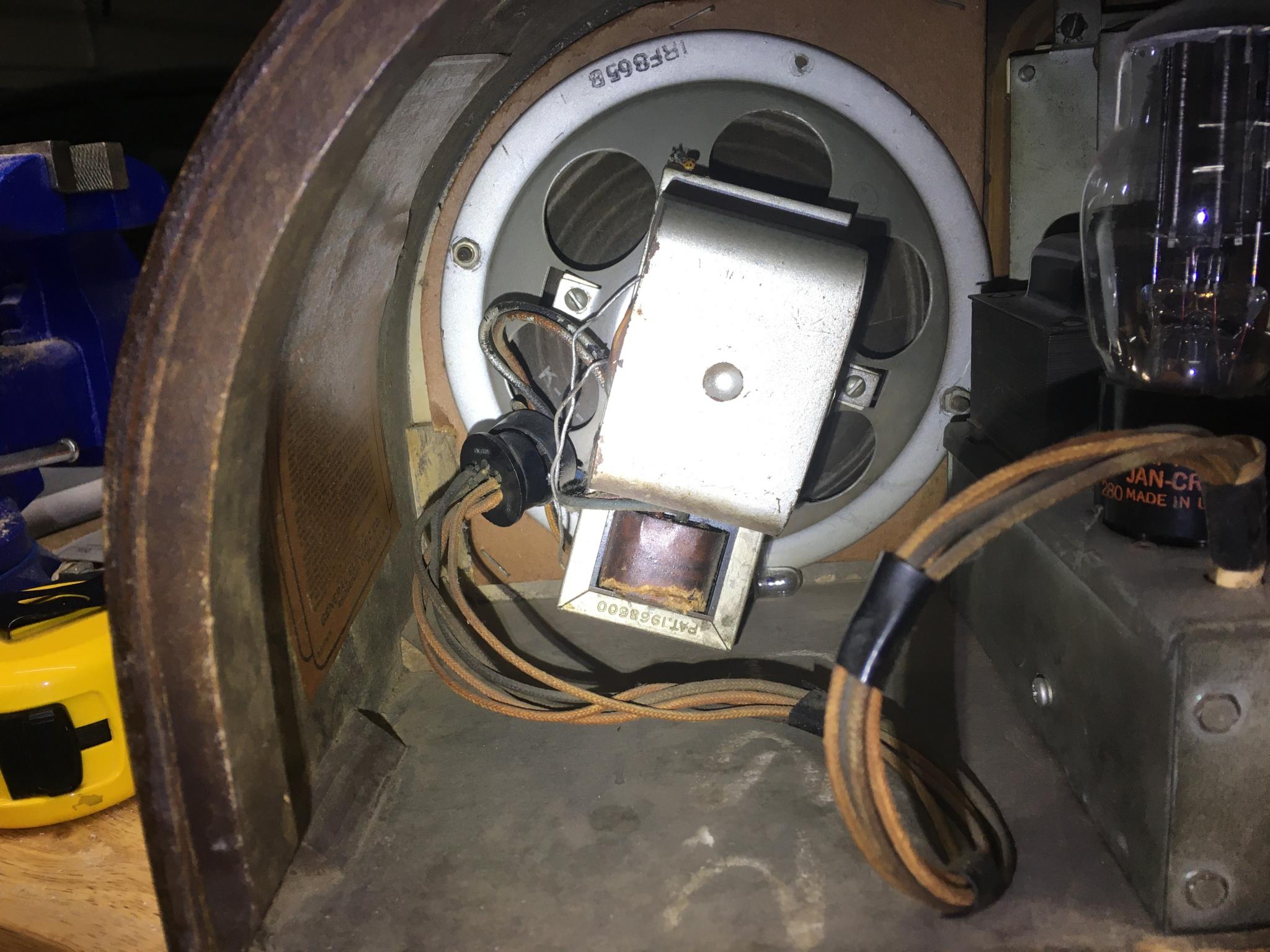
That is a nice looking radio.
So, my project in my head so far involves an RPi zero W as an airplay target, but I would love to be able to play audio CDs. I know, I'm a weirdo. Is there a way in the HifiBerry software to play CDs? And I have some honest to goodness black and white CRT screens that I think could be integrated into a really cool vintage looking case, and I'd love to have a simplified and stylized display of the currently playing track number on the screen. Nothing else. Do you know if that's possible and relatively straightforward? That might be beyond your involvement on this stuff so far but since you made this project come into my head I thought I'd ask.











































